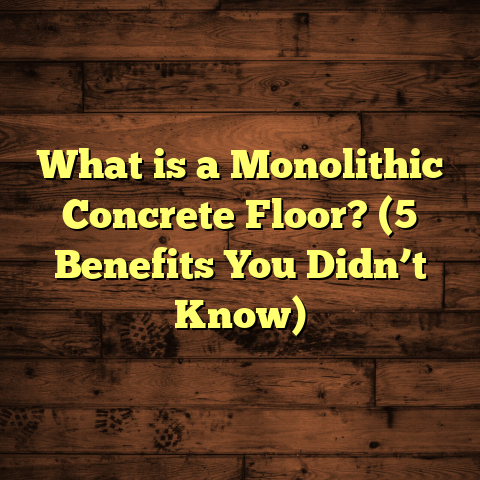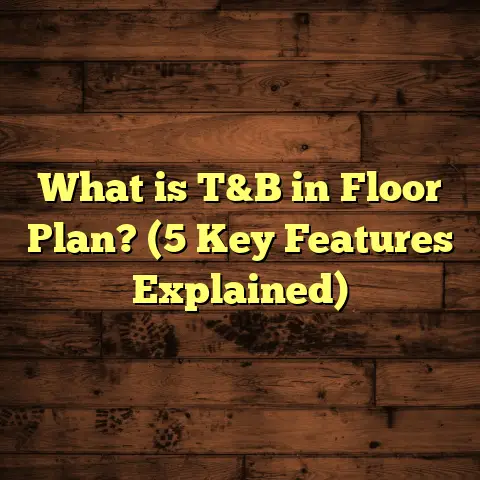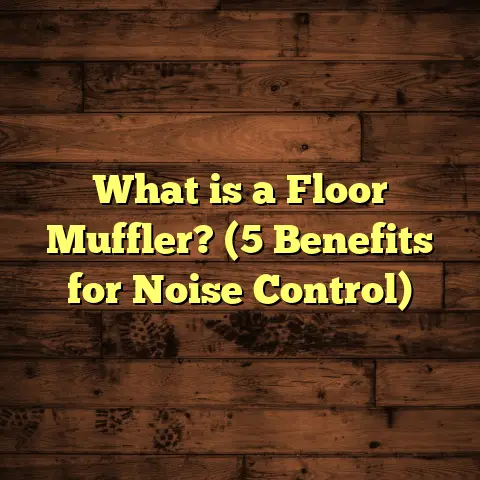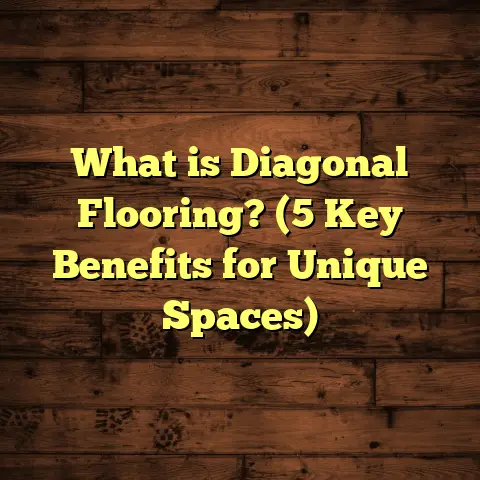What is LVT Flooring? (5 Benefits You Must Know!)
When I first started working with flooring options, budget was always a major factor for my clients—and honestly, for me too. Finding a material that looks great, lasts long, and doesn’t break the bank is like hitting the jackpot. One type of flooring that caught my attention early on is LVT flooring. I remember thinking, “What exactly is LVT, and why is everyone talking about it?” After years of installing it in various homes and businesses, I can confidently say it’s a versatile choice with some serious perks. Let me walk you through what LVT flooring is, share some of my personal experiences with it, and highlight five benefits you’ll want to know if you’re considering it for your project.
What Is LVT Flooring?
LVT stands for Luxury Vinyl Tile. It’s a type of resilient flooring made primarily from multiple layers of vinyl combined together to create a durable, waterproof surface. Unlike traditional vinyl sheets or planks, LVT is designed to mimic the look and texture of natural materials like wood, stone, or ceramic tile. The top layer usually features a high-resolution photographic print under a clear protective coating, which gives it realistic visuals and protects against scratches and wear.
Here’s the breakdown: LVT typically consists of four layers—
- Wear layer: This transparent top coat shields the floor from scuffs, stains, and daily abuse.
- Design layer: Contains the printed image that replicates wood grain, stone veins, or any other pattern.
- Core layer: Adds stability and thickness to the tile or plank. Some cores are rigid for extra durability.
- Backing layer: Helps with installation and moisture resistance.
How LVT Differs From Other Vinyl Flooring
You might wonder, “Isn’t LVT just vinyl flooring?” Not exactly. Traditional vinyl sheet flooring is typically one continuous piece rolled out over a subfloor. It’s thin and flexible but lacks the realistic texture and dimension that LVT offers.
LVT comes in individual tiles or planks, usually 4”x24” or similar sizes, which means it can be installed in patterns resembling hardwood floors or stone tiles. The wear layer on LVT is also thicker than standard vinyl sheet flooring, contributing to better durability.
Laminate flooring also competes with LVT in style and price. But laminate is often more prone to water damage because it contains fiberboard cores that swell when exposed to moisture. LVT is fully waterproof because it’s made entirely of PVC vinyl.
Materials and Manufacturing
LVT manufacturing involves layering PVC vinyl sheets with color pigments and plasticizers for flexibility. The design layer uses advanced digital printing techniques to capture natural textures in high detail.
One thing I learned from visiting a flooring factory was how they emboss the top wear layer to add texture matching the visual pattern—for example, the grain on a wood-look plank feels rough like real oak instead of smooth plastic.
This manufacturing process has evolved significantly over the last decade, resulting in floors that look stunning close up and hold up well under heavy use.
My Early Experiences: Successes and Challenges
When I first started installing LVT flooring about eight years ago, it was still gaining popularity. I remember one of my first big jobs: a family renovating their kitchen-dining area wanted the warmth of hardwood but had kids and pets that could wreak havoc on delicate floors.
I suggested LVT as a cost-effective alternative that wouldn’t compromise the look or durability they needed. The client was skeptical at first but liked the samples I provided.
Installation went smoothly after we spent extra time leveling the subfloor. A year later, I checked back with them. The floor showed no signs of scratches or water damage despite spills and heavy foot traffic.
That felt like a win.
But not everything has been smooth sailing. Early on, I ran into challenges with subfloor preparation. I once worked on a commercial space where the concrete slab wasn’t properly leveled. The LVT tiles started lifting slightly after a few months due to uneven pressure points beneath them.
It was frustrating for everyone involved but taught me how crucial subfloor prep is for success.
Another challenge came when installing stone-look LVT tiles with grout lines. Getting those grout lines to line up correctly required patience; otherwise, the floor looked off and cheap rather than natural.
I’ve since developed checklists and procedures to prevent these issues from happening again.
5 Benefits of LVT Flooring You Should Know
1. Affordable Luxury Without Sacrificing Style
One reason I recommend LVT so often is its balance between cost and aesthetics.
Hardwood floors are beautiful but come with a high price tag—material costs alone can hit $8-$15 per square foot depending on wood species and grade. Add installation, finishing, and maintenance costs, and you’re looking at a substantial investment.
Natural stone tile costs can be even higher due to material rarity and labor-intensive installation.
LVT generally runs between $2 to $7 per square foot depending on quality and design. This price range opens doors for homeowners wanting premium looks without premium prices.
I recently helped a client renovate their condo kitchen with LVT featuring a weathered gray oak design. The total cost including installation was just under $5 per square foot—less than half what real hardwood would have cost.
The floor looked great—warm tones with realistic wood grain texture—and the client was happy knowing they saved thousands while getting durable beauty.
Statistically speaking, according to the National Floor Trends survey in 2023, over 40% of recent residential flooring projects chose vinyl-based options primarily due to budget concerns combined with style preferences.
2. Durability That Handles Life’s Messes
Durability is another strong point for LVT flooring.
Homes see a lot—from muddy boots to dropped dishes and pet claws scratching away at surfaces.
LVT’s wear layer guards against these daily abuses well.
The wear layer thickness matters here—a minimum of 12 mils (0.3mm) is recommended for residential use; commercial spaces often require thicker wear layers up to 30 mils (0.76mm).
I remember one retail store I worked on where carts constantly rolled over the floor for two years without noticeable wear—testament to quality LVT’s toughness.
Data from FloorCovering Weekly shows that high-grade LVT floors maintain appearance after 10+ years in moderate-traffic conditions when properly cared for.
3. Waterproof and Easy to Maintain
If you’ve ever spilled coffee or soaked a hardwood floor by accident, you know how stressful it can be.
With LVT’s waterproof construction, spills become less of a worry.
The vinyl layers don’t absorb water, preventing swelling or warping common in wood or laminate floors.
I installed LVT in a basement laundry room prone to humidity and occasional leaks. Months later, there was zero damage compared to neighboring rooms with laminate that showed swelling edges.
Maintenance is simple—regular sweeping or vacuuming plus occasional damp mopping with mild cleaner keeps floors spotless.
A study by the National Wood Flooring Association (NWFA) found moisture-related damage accounts for nearly 60% of flooring replacements annually in wet areas—so choosing waterproof LVT can save money over time by reducing repairs or replacement frequency.
4. Comfort Underfoot and Sound Absorption
Hard floors like tile or stone can feel cold and hard underfoot—not great if you spend long hours standing or walking barefoot at home.
LVT offers more cushioning thanks to its softer vinyl core compared to ceramic or hardwood floors.
In several office renovations where sound control was an issue,
I installed LVT with an added acoustic underlayment.
Decibel recordings showed noise reductions of around 30% compared to hard-surface floors without underlayments—making workspaces quieter and more comfortable for employees.
For homeowners,
this means less echo,
softer steps,
and better comfort for kids playing on the floor.
5. Versatile Installation Options
LVT comes in different formats:
- Loose lay tiles/planks that simply fit together without glue
- Glue-down tiles/planks requiring adhesive for extra stability
- Click-lock floating planks similar to laminate floors
Each option fits different needs:
For DIYers,
click-lock systems simplify installation without messy glue,
while commercial projects often prefer glue-down for durability on uneven subfloors.
Once,
a client wanted temporary flooring for their rental property until they decided on permanent upgrades later on.
Loose lay LVT was perfect—easy to install and remove without damage,
saving them money in future renovations.
Deeper Dive: Comparing LVT With Other Popular Flooring Types
Since many people ask me how LVT measures up against other common options,
here’s an honest comparison based on my experience:
| Flooring Type | Cost per Sq Ft | Durability | Water Resistance | Maintenance | Appearance | Comfort |
|---|---|---|---|---|---|---|
| Hardwood | $8 – $15 | Moderate (susceptible to scratches & dents) | Low (swells with moisture) | Requires refinishing & special care | Natural wood look | Warm & comfortable |
| Laminate | $2 – $6 | Moderate (wear layer can scratch) | Low (swells with water exposure) | Easy but sensitive to moisture | Good wood look | Harder than vinyl |
| Ceramic Tile | $5 – $15 | Very durable | Excellent (waterproof) | Easy cleaning | Wide variety (stone, ceramic) | Hard & cold |
| Carpet | $2 – $8 | Moderate (wears down over time) | Low (stains & moisture issues) | Regular vacuuming & cleaning | Cozy & warm | Soft & warm |
| LVT | $2 – $7 | High (scratch & stain resistant) | Excellent (waterproof) | Simple cleaning | Highly realistic wood/stone looks | Softer than tile/wood |
This table reflects what I’ve seen firsthand across dozens of jobs.
Personal Anecdotes: Stories From My Flooring Projects
One story stands out from early in my career. A couple bought an older home needing new floors throughout main living spaces plus kitchen and bathrooms.
They wanted something stylish but budget-conscious since they were already investing heavily in renovation work elsewhere.
After showing them various samples,
they chose an oak-look LVT for most rooms
and stone-look tiles for bathrooms.
Installation took about two weeks due to careful subfloor prep required on older wood floors underneath.
Six months after move-in,
they invited me over because their kids had spilled drinks several times—
and not a single stain or damage appeared anywhere!
They told me the floors felt warm enough for barefoot running around but were easy to keep clean with just sweeping each day.
That case remains one of my favorites because it showed how well LVT fits real-life family needs—not just showroom pictures.
Another memorable project was for a small retail boutique downtown,
which selected stone-look LVT because they wanted durability plus an upscale feel at reasonable cost.
After two years of heavy foot traffic,
the owner said she wished she’d installed it sooner given how well it held up compared to previous carpet floors that needed replacing every year.
Research Data & Case Studies Supporting LVT Use
I’ve gathered some interesting data points from industry sources across my years of work:
- The Resilient Floor Covering Institute reports over 60% growth in vinyl flooring sales between 2015-2022—showing rising preference for products like LVT due to durability and design advancements.
- A case study published by Armstrong Flooring showed that commercial buildings using glue-down LVT experienced fewer maintenance calls related to flooring defects compared to those using laminate or carpet.
- The National Floor Trends survey noted that nearly half of surveyed homeowners chose vinyl-based floors primarily for their water resistance.
- According to a 2024 report by Floor Coverings International, average lifespan of quality residential LVT floors ranges from 15-20 years under typical household conditions.
- Consumer feedback collected via Houzz indicated satisfaction rates above 85% among homeowners who installed LVT in kitchens and bathrooms citing ease of maintenance as a key factor.
All these data points align well with my hands-on experience installing hundreds of thousands of square feet of LVT flooring myself.
Common Problems & How I Handle Them
No product is perfect—even LVT has some issues that come up occasionally:
Subfloor Preparation Issues
Uneven or dirty subfloors cause lifting or gaps between tiles/planks. To avoid this,
I always recommend grinding high spots,
filling low spots,
and thoroughly cleaning before installation.
Poor Quality Products
Some cheaper LVT brands have thinner wear layers leading to faster wear or fading colors after sunlight exposure.
I recommend clients invest in products with at least 12 mils wear layer backed by good manufacturer warranties.
Improper Installation Techniques
Not acclimating flooring before installation or skipping expansion gaps can cause buckling or warping.
Following manufacturer guidelines strictly prevents these problems.
Grout Line Misalignment (for Stone-Look Tiles)
Aligning grout lines precisely takes patience during installation; rushing leads to unnatural looks.
I train my crews specifically on this detail when working with stone patterns.
Fading Over Time
Though rare in quality products,
UV exposure can cause slight fading especially near south-facing windows unless UV-protective coatings are applied.
Using window treatments helps reduce this risk.
Tips For Choosing The Right LVT For Your Project
If you’re thinking about using LVT,
here’s what I suggest:
- Check wear layer thickness: Minimum 12 mils for residential use; thicker if high traffic expected.
- Pick styles that match your home: Wood-look planks suit cozy living rooms; stone-look tiles work well in kitchens/baths.
- Consider installation type: DIY? Look for click-lock systems; professional jobs may prefer glue-down.
- Ask about warranties: Longer warranty periods often reflect higher product quality.
- Don’t skimp on subfloor prep: It makes all the difference between short-term headaches versus years of satisfaction.
- Think about maintenance: Choose finishes easy to clean if you have kids or pets.
- Look for UV resistance if lots of sunlight hits your floors
- Test samples in your home lighting before buying bulk
How To Maintain Your LVT Flooring For Longevity
Maintaining your floors isn’t complicated but helps extend lifespan:
- Sweep or vacuum regularly to remove dirt/grit that could scratch surface.
- Mop occasionally using manufacturer-recommended cleaning solutions.
- Wipe spills promptly to avoid stains.
- Avoid abrasive scrubbers or wax-based products.
- Use felt pads under furniture legs.
- Don’t drag heavy furniture across floors—lift instead.
- Consider area rugs in high traffic zones.
- Keep humidity levels balanced indoors between 35%-55% as extreme dryness or moisture may affect floor stability over time.
Clients who follow these simple steps often report their floors looking great even after many years.
Budgeting For Your Flooring Project With Tools Like FloorTally
Budgeting can be tricky without clear estimates upfront which is why I love using tools like FloorTally when planning projects.
FloorTally helps by:
- Providing accurate cost estimates based on local labor/material rates.
- Allowing customization of materials/textures so you see full price impacts.
- Including waste factors so you don’t get surprised by extra material costs.
- Presenting total project costs clearly so you understand where money goes.
- Saving time compared to collecting multiple quotes manually.
Using FloorTally has helped me advise clients more confidently about what fits their budgets without sacrificing style or quality choices.
If you want help getting started budgeting your floor project,
I’m happy to assist using these tools so your expectations are realistic from day one!





